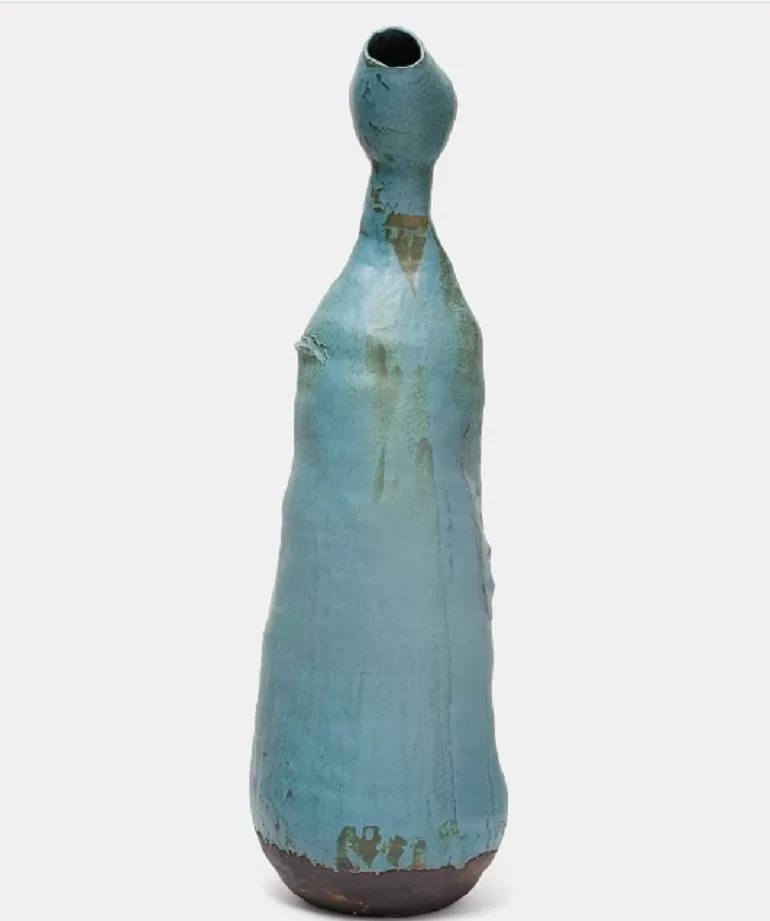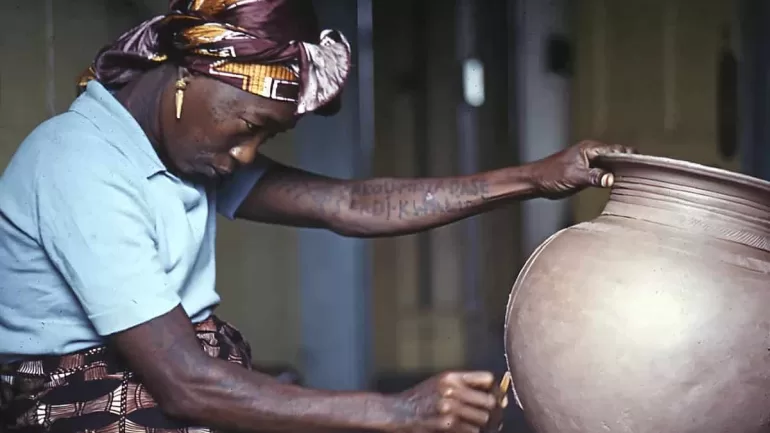ART REVIEW
From Ladi Kwali to Simone Leigh, discover how Black women ceramic artists are forging a new, insurgent canon and rewriting the rules of art history.
BY KAZEEM ADELEKE, ARTCENTRON
NEW YORK, NY-The Body Vessel Clay exhibition at the Ford Foundation Gallery is more than a collection of works; it is an insurgent re-mapping of art history. This powerful show brings together three generations of Black women ceramic artists who use clay as a medium for memory, political commentary, and ancestral storytelling. It is an electrified, multi-generational reclamation of clay as a site of ancestry and revolution.
Centered around the seismic legacy of Nigerian master potter Ladi Dosei Kwali, the exhibition offers a rare and expansive platform for Black women clay artists to converse across continents and centuries. Premiering in the United States on the centenary of Kwali’s birth, this landmark show features over fifty works. They include vessels, performance films, sculptures, and installations. The works unearth silenced genealogies and inscribe new mythologies into the very sediment of clay. Curated by the visionary Dr. Jareh Das, Body Vessel Clay dares to situate African traditions, diasporic craft, and contemporary political praxis within the same fertile ground. It is a must-see for anyone interested in contemporary ceramics and global art history.
The Matriarch: Ladi Kwali’s Seismic Legacy
Ladi Kwali’s influence on African art history is monumental. Born in Kwali, Nigeria, her journey from domestic potter to global ceramic icon defied colonial and patriarchal boundaries. Her traditional Gbari coiling and burnishing techniques, learned matrilineally, formed the foundation of her work at the Pottery Training Centre in Abuja. The center was established by British potter Michael Cardew in 1952. There, Kwali absorbed European stoneware and glazing methods, fusing them with indigenous forms like the tulu (water pot). Her hybrid vessels—ritualistically shaped yet technically modern—critically shifted the global perception of African ceramics.
Exhibited alongside rare archival ephemera—including photographs, letters, and press clippings. Kwali’s presence in Body Vessel Clay reasserts African women’s historical centrality in the ceramic arts. Her depiction on Nigeria’s 20-naira note is more than symbolic; it is a public enshrinement of her role as a cultural ambassador whose influence reverberates through the hands of today’s most avant-garde Black women ceramic artists.
Generational Echoes: From Protégé to Master
Kwali’s techniques became a transcontinental inheritance. Magdalene Odundo, a towering figure in contemporary ceramics, absorbed Kwali’s methods during her 1974 apprenticeship in Nigeria. Odundo’s vessels—sensual, almost corporeal, with dark, gleaming, burnished surfaces—are the tangible outcome of this cross-cultural mentorship. Their elongated, asymmetrical silhouettes echo ancient African, Greco-Roman, and personal ritual vocabularies, blurring the line between body and vessel. Her work affirms the ontological weight of clay—not merely as a medium, but as embodied memory and a powerful form of material culture.
Magdalene Odundo’s ceramics breathe with a quiet intelligence—refined, sinuous forms that feel as if they emerged from centuries of contemplation. Her burnished surfaces shimmer with patience, achieved through ancient methods like terra sigillata, where layers of fine slip are meticulously polished to a luminous sheen. Though vessel-like, her works resist utility, becoming instead abstract metaphors for transformation, identity, and the body itself. Tracing influences from Kenyan coiling, Nigerian surface treatments, and the red clay of Pueblo traditions, Odundo composes an aesthetic language that is deeply global yet intensely personal.
In pieces like Symmetrical Reduced Black Narrow-Necked Tall Piece, the form gestures toward elegance but holds within it a more important inquiry: What does it mean to contain, to open, to endure? Odundo’s practice, a towering achievement among Black women ceramic artists, is less about function than about philosophical resonance—where each vessel becomes a metaphor for being, for ancestry, and for the quiet negotiation between the internal world and outward form.
Kwali’s influence also extends to her Gbari peers and protégés. Artists like Halima Audu and Asibi Ido carry forward her techniques with autonomous flair. Their works reflect a regional continuum—modern expressions rooted in ancestral soil.
Clay as Resistance: Contemporary Visionaries
The exhibition’s contemporary artists actively engage the medium to confront histories of colonialism, enslavement, and cultural erasure. Their practice reframes clay as an urgent tool for art and social justice.
Simone Leigh’s towering ceramic and bronze structures collapse the boundaries between architecture and anatomy. Her Village Series (2023–2024) featured prominently. It draws from vernacular African dwellings like the Mossi house in Burkina Faso. She reconfigures the Black female body as both shelter and archive. Leigh’s works are steeped in Black feminist traditions and stand as sovereign monuments. They are relics of diasporic resilience and an undeniable force in the ceramic canon.
New Jersey-born artist Adebunmi Gbadebo digs directly into her lineage—literally. She works with clay from Fort Motte, South Carolina. This is where her ancestors were enslaved, integrating human hair, indigo, and rice into her vessels. These visceral artifacts, often appearing pocked and textured, become reliquaries of grief, remembrance, and reclamation. The earth is no longer passive; it is politicized, embodied, and insurgent.
Essential Voice Among Black Women Ceramic Artists
Gbadebo is another essential voice among Black women ceramic artists interrogating the sacred. Her ceramics are acts of devotion and excavation—each vessel a quiet monument carved from the earth that remembers. She engages clay as a living archive, sourcing material from burial sites, forgotten graves, and lands bearing the scars of enslavement. In the work, Scott, Ida, 1892–1945, and Asleep in Jesus, soil from an ancestor’s resting place becomes the very material of remembrance.
In Sam, another piece by the artist, clay speaks on behalf of a community that history chose to erase. Through coiling techniques rooted in African traditions, her slow, rhythmic process is almost prayerful. It allows the vessels to hold more than form; they carry the weight of silence and the urgency of visibility. Gbadebo’s work blurs the line between the spiritual and the political, asserting that memory lives not just in books but in bodies, in landscapes, and in matter.
Anina Major: Weaving Memory into Form
Bahamian artist Anina Major reinterprets the ephemeral art of straw plaiting—a tradition at risk of erasure—by translating it into ceramic permanence. Her meticulously crafted clay forms mimic woven palm fronds, carrying the weight of colonial disruption and cultural survival. By softening ceramic to emulate straw’s pliancy, Major reclaims indigenous craft aesthetics from the brink of extinction.
Anina Major reshapes memory and matrilineal craft through her innovative ceramic practice. In her work, the softness of straw meets the rigidity of fired clay. Rooted in the Bahamian art of plaiting, a tradition she inherited from her family’s women, the artist transforms this historically domestic technique into a sculptural language of migration, memory, and material hybridity. Her experimentation with clay recipes resulted in a pliable medium that mimics the flexibility of palm leaves. This technique allows her to weave three-dimensional forms that echo baskets, shelters, and even waves.
In Salt Crusted Ribs (2024), glazed stoneware fuses with sea glass and sand, evoking a dialogue between land and ocean, home and elsewhere. Through plaited clay, Major, a distinct voice among Black women ceramic artists, speaks to diasporic crossings. At this threshold of artistic dialogue, these vessels hold not only shape but also story, and the gesture of weaving becomes an act of remembering and reimagining what it means to belong.
Bisila Noha: Reconstructing Lost Lineage
In her project Searching for Kouame Kakahá, Bisila Noha shapes powerful, two-legged vessels that honor forgotten potters of the Global South. Her clay bodies articulate absence as presence—each forms a vessel for the unnamed, the undocumented, and the erased. Her practice channels mourning into form, collapsing the temporal distance between then and now.
Black Women Ceramic Artists: Reorienting Art history

Phoebe Collings-James, Infidel [virtuosic], 2025. Glazed stoneware ceramic 112 x 32 x 32 cm. Photo: Tom Carter. Image Ford Foundation Gallery/ Artist and Arcadia Missa, London
Phoebe Collings-James
In Phoebe Collings-James’ evolving body of work, clay becomes a site of tension and tenderness. In these works, histories of dominance and disobedience collide. Her Infidel series sculptures unmoor familiar forms, turning them into uneasy silhouettes—limbless, beaked, and delicately balanced. They appear as if mid-transformation, caught between creature and relic, echoing the rituals and resistances of the Black diaspora.
Drawing loosely on West African and Caribbean clay traditions, her pieces are not just objects but propositions. They are vessels of memory, grief, and spiritual insurgency. The term infidel is not just inherited but claimed, bent into a symbol of proud estrangement and silent revolt. These figures do not scream; they brood. Their stillness holds power, suggesting that refusal can be an act of creation. Pieces like Infidel (virtuosic) and Infidel (knot song) hum with this radical quiet. Their unglazed truths are coated instead with a sharp fragility that resists easy interpretation. This technique affirms Collings-James’s vital position among contemporary Black women ceramic artists.
Performing Clay: Body As Vessel, Vessel As Performance
The exhibition transcends the static by embracing clay’s performative dimension. Artists use the material to stage ritualistic and enduring acts of resistance. In Clay (2015), filmed by Webb-Ellis, artist Jade de Montserrat engages in ritualistic excavation—her body plunging into soil, sculpting, disappearing. Her performance invokes Clay as a partner in healing and historiography.
Chinasa Vivian Ezugha’s durational piece Uro (2018) leverages endurance as a metaphor. Encased in 30 kg of clay, her body moves under its burden in a six-hour performance—laboring, shaping, and reshaping self and soil.
Julia Phillips, in her video work Becoming (the Hunter, the Twerker, the Submitter), fractures identity into archetypal performances. Using the body as an instrument, she offers herself as a battleground to interrogate the sexualization, subjugation, and empowerment embedded in clay’s metaphorical weight.
Deconstructing Colonial Ceramic Narratives
A critical achievement of Body Vessel Clay lies in its decentering of colonial hierarchies. By placing African and diasporic women at the forefront, the exhibition dismantles the binary of “folk craft” versus “studio art.” Curator Dr. Jareh Das brings an embodied, peripatetic, and insurgent curatorial method. Staging the exhibition as a polyphonic score where each vessel and video sings a different verse of reclamation. Clay is not primitive nor passive—it is conceptual, intellectual, and political. The inclusion of works by figures like Michael Cardew and George Sempagala provides a necessary contrast, mapping the colonial infrastructure, they<strong> both engaged with and resisted. These juxtapositions heighten the radicality of the women featured. It foregrounds how their practices refuse erasure and assert alternative canons of mastery.
A Living Clay Cosmology
The Body Vessel Clay exhibition is crucial because it reorients the history of contemporary ceramics. It celebrates the essential, often-overlooked contributions of Black women ceramic artists. It shows that clay is a living archive—a vessel for legacy, defiance, and new beginnings.
In this extraordinary convergence of artists—Ladi Kwali, Simone Leigh, Adebunmi Gbadebo, Anina Major, Magdalene Odundo, and others—a new ceramic canon emerges. Through their hands, clay is reanimated as an agent of memory, resistance, and spiritual continuity. This exhibition is more than a display; it is a cosmology that speaks in ancestral tongues and molds the future with hands that remember.
- Featured Image: William Alfred Ismay (W. A. Ismay). Photograph of Ladi Kwali at a pottery demonstration in England. 1970s. York Museums Trust. The W. A. Ismay Bequest, 2001. Photo: W. A. Ismay, © York Museums Trust.
Body Vessel Clay: Black Women, Ceramics & Contemporary Art, runs through December 6, 2025 at the Ford Foundation Gallery.
